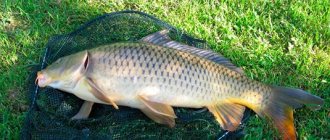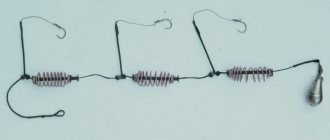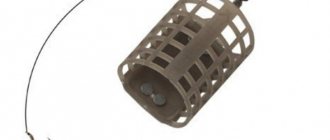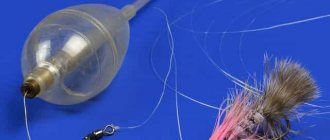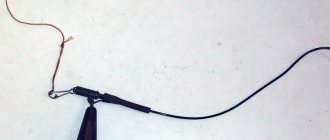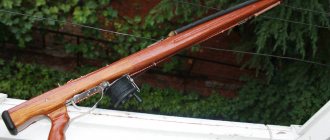Theory
The appearance of flat-method equipment was due to the experience of fishing with the classic feeder method, which uses triangular feeders with one or two loaded ribs. One of the main conditions for effective fishing using the classical method is the correct placement of the hook with the nozzle, which is pressed into the bait.
After washing away the sticky mixture pressed into the feeder, the hook is released and takes a working position in which the floating bait will be clearly visible to the fish. Therefore, the hook is placed on the side opposite the loaded part of the feeder, so that after it gets into the water and the bait is washed away, it ends up at the top.
Unfortunately, often when fishing using the classic method, the hook with the nozzle ends up under the feeder. This greatly reduces the chances that after the bait is washed away, the bait will be accessible to the fish.
This is where the idea arose to make an open feeder with a flat, loaded bottom, which would ensure the correct position of the hook at the bottom of the reservoir. This means it will increase the chances of catching fish.
Now it is difficult to say which company was the first to release flat feeders (flat). A worthy product was presented by the Preston company, which now occupies a leading position in the market of flat feeder products.
The flat feeder differs from other method feeders in that it has a flat, loaded bottom. Due to this, it smoothly descends in the water column and the bait into which the hook is trampled always ends up at the top. That is, with the help of these feeders, the problem associated with the possibility of a hook with a nozzle getting under a standard feeder was solved.
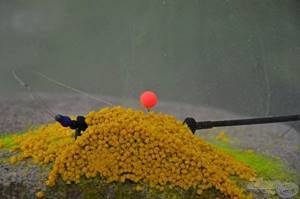
The first models of flats had a light weight, 15-30 grams, and were used for short-range fishing in English reservoirs of the classic type, which were small in size and had a significant number of fish. Such reservoirs are widespread not only in the UK, but also in other European countries. It is not surprising that the new fishing method gradually attracted the attention of many fishermen in the Old World.
When we became interested in it, it turned out that we would have to modify the flat installation method, since we don’t have many small and densely stocked reservoirs. Large expanses of artificial and natural standing reservoirs required long casting, which is impossible with light feeders. And I wanted to catch bigger fish, but it’s difficult to do this with delicate equipment, hooks and lines, even if it’s possible in principle.
After the necessary modifications, including making the feeders heavier, the flat equipment acquired a lot of advantages, which we wanted to talk about in this article.
Main advantages of the equipment
The most popular are flats from Preston, Drennan, ESP, Korum and they differ in:
- form;
- weight;
- sizes;
- coloring;
- frame configurations for holding bait;
- feed containers;
- type of connectors for tying a leash;
- loading form;
- cost.
The flat method is an economical type of fishing, but the price of imported feeders is still high, so it is welcome that our manufacturers have begun to compete with foreign brands and even win this competition.
The flat must have a streamlined shape in order to “break through the wind when casting, and a special mold device or “presser” is used to press the bait.
With the help of this gadget, it is possible to give a structure filled with bait excellent flight characteristics, and this allows you to fish at ultra-long distances. But other qualities of feeders are also important, on which their choice depends.
Flat weight
Feeders offered by manufacturers have a weight range from 10 to 120 grams, covering all possible fishing conditions.
When fishing at short distances, light weight flats, up to 30 grams, are used, and at a distance of 40 meters and further, heavier feeders from 40 to 120 grams are needed.
The choice of flat weight also depends on the test of the feeder rod used for fishing and this should also be taken into account. When testing a rod weighing 90 grams, feeders weighing up to 90 grams are used along with bait.
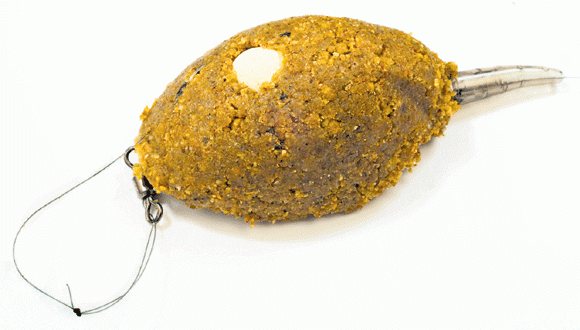
Unfortunately, situations are possible when, during a power cast, a rod breaks, the test of which is lower than the weight of the flat with bait. But this happens if the load on the form is maximum.
The transformation of spring feeders has given rise to many varieties of feeder feeders in shape, design, size and purpose.
Flat feeders for fishing with the Method can be roughly divided into three groups:
- Classic flat feeders;
- Banjo (banjo) - a feeding method of small volume, round in shape with sides;
- Scoop - feeder feeders of a semi-closed type.
Classic flat feeders for flat feeders are used in most cases and are suitable for fishing during active biting. They differ among themselves in weight, volume, shape of the platform, number of ribs and the distance between them.
Banjo feeders for flat feeders have a round shape and are light in weight and volume. Suitable for catching cautious fish.
Scoop type feeders are often used for pellets, but are also suitable for regular groundbait. Thanks to its shape, the scoop delivers bait to any depth without loss.
Many flat feeders come complete with a press - a device for more convenient and dense filling of the feeder with bait. Fishermen call such molds tramplers.
Among the manufacturers of feeder flat feeders are Preston, Drennan, ESP, Korum, Browning, AVID and TechnoKarp.
Many reservoirs inhabited by large carp, crucian carp and other species of fish from the carp family create problems when fishing with most feeder equipment. The ineffectiveness of other rigs is mainly due to a soft bottom with a lot of algae and snags. Flat fishing helps in such situations due to the following features:
- The flat shape of the sinker and its large area prevent the equipment from falling into the silt.
- Since the bait is fed directly into the feed, there is no problem with snagging on algae, snags or debris at the bottom of the reservoir.
- A fish attracted by bait may not pay attention to the bait, which lies nearby on the ground (as in most feeder installations, especially with the use of long leashes), but the peculiarities of food intake by fish of the carp family make swallowing the hook almost inevitable if it is located in the thickness of the bait.
- Night carp fishing using the flat method is more convenient than using other rigs, since there is no need to frequently feed the point, which means you don’t need to make a lot of casts in poor visibility conditions.
Advantages of a flat feeder
Advantages:
- All peaceful fish, including trophy ones, are successfully caught with this tackle;
- even in a short, one-day session it is possible to get a decent result;
- flat equipment is democratic, and anyone can learn to fish with it;
- Compared to carp fishing, fishing costs are much lower, and the fish caught is almost the same;
- The variety of baits and baits used allows the angler to show all his imagination in order to find the key to capricious fish.
It is possible and necessary to catch big fish on a flat feeder and, as practice shows and the real results of anglers, trophies 10+ regularly end up on the mats of successful flat feeders, and this is not surprising.
In terms of catchability, flat fishing is as close as possible to classic carp fishing. But some, including famous carp fishermen, show their disdain for this method of catching trophies.
It seems that tournaments are just around the corner in which, along with classic carp anglers, flat feeders will also participate. And some well-known masters of carp fishing may be very unpleasantly surprised by the results of these competitions, and not in their favor.
Returning directly to the flat, we note that now not only trophy carp are caught with this equipment, but also:
- grass carp;
- crucian carp;
- bream;
- carp;
- silver carp.
It turns out that all peaceful white fish can be successfully caught on a flat feeder and therefore its popularity is growing rapidly.
The main advantages of flat method fishing
Thanks to the use of equipment with a flat method feeder, there is a chance to catch large fish, even in short sessions taking place during one daylight hours.
Among the advantages of a flat feeder we highlight


